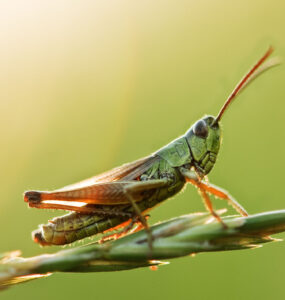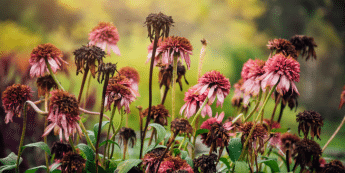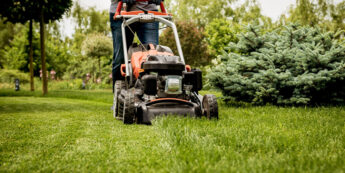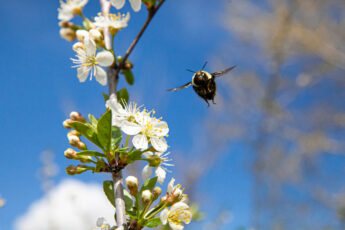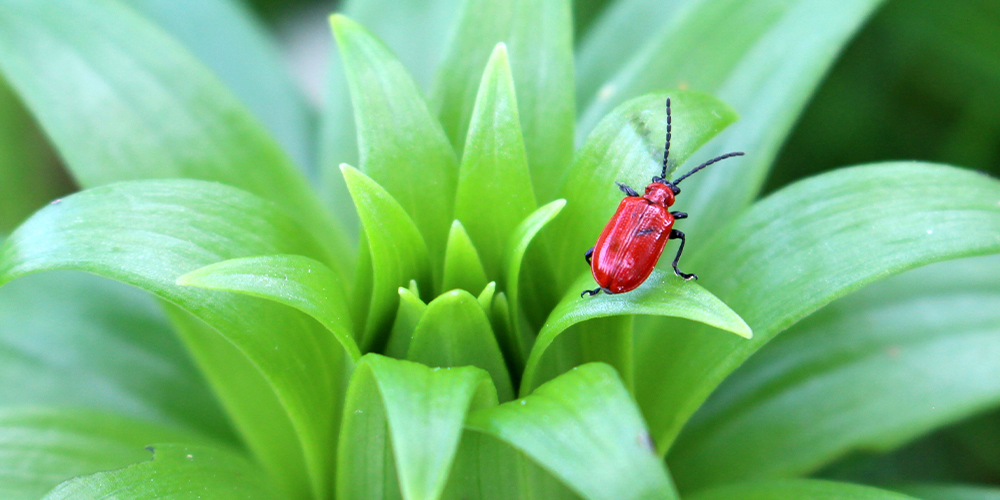
The circle of life works in mysterious ways, but one thing we’ve learned is that each year brings its own “˜pest of the moment'””a bug that suddenly seems to be everywhere! Early identification of these garden pests is critical; the sooner we know what to look for, the sooner (and better) we can protect our plants. Here’s what we’re seeing in Edmonton gardens this year.
Garden Pest Identification: Scarlet Lily Beetle
This year’s biggest offender is none other than the scarlet lily beetle (Lilioceris lilii). This invasive species has become quite a problem in the Edmonton area, and this year it’s back with a vengeance. As their name suggests, they are bright red and stand out easily in the garden””their shells look a bit like walking crimson-painted fingernails.
These little monsters have a voracious appetite for anything in the Liliaceae family, including your fritillaries, asiatic and Oriental lilies, lily of the valley, and potato plants””along with many others. The beetles reproduce rapidly, and a colony is capable of completely decimating a crop within a week’s time. These red bugs are not joking around!
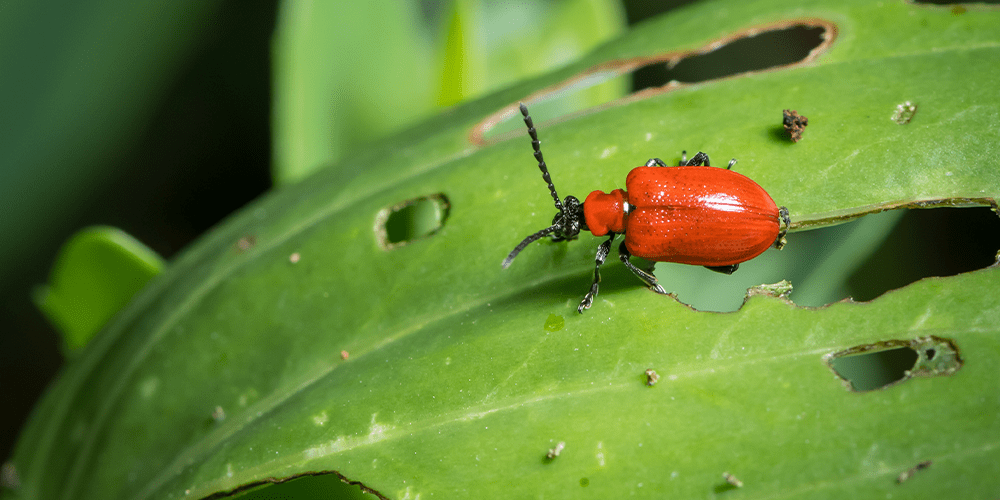
If you are growing lilies in Edmonton this year, it’s imperative that you check your plants daily for signs of this pest. As garden pests go, identification of the adults is easy, but where many gardeners trip up is missing the eggs and larvae. Check the midribs along the undersides of your lily leaves for brown, sticky masses””these are the eggs. The eggs eventually hatch into yellow, brown, or orange larvae that immediately get to work feeding on the plant. Larvae feed without stopping for 24 days before pupating, during which time they cause far more damage than the adults. Telltale early damage includes elongated holes in the centres of the leaves.
Several control methods exist for these garden pests, but all should be combined with daily scouting and hand-picking, which helps to interrupt the colony’s life cycle. Surround susceptible plants with diatomaceous earth as an excellent preventative, while insecticides like carbaryl, malathion, methoxychlor, and rotenone are considered the most effective against the bugs. The beetles have a high survival rate, and they are undeterred by moisture from your hose or watering can, so if you discover an infestation, aggressive treatment is required.
Unfortunately, there is no “easy way out” to treat the scarlet lily beetle. If they discover your lilies, you really only have two options””punch back, or accept that you won’t have lilies this year! The choice is yours, but if you do step into the ring, our Edmonton garden centres are equipped to help you win the fight.
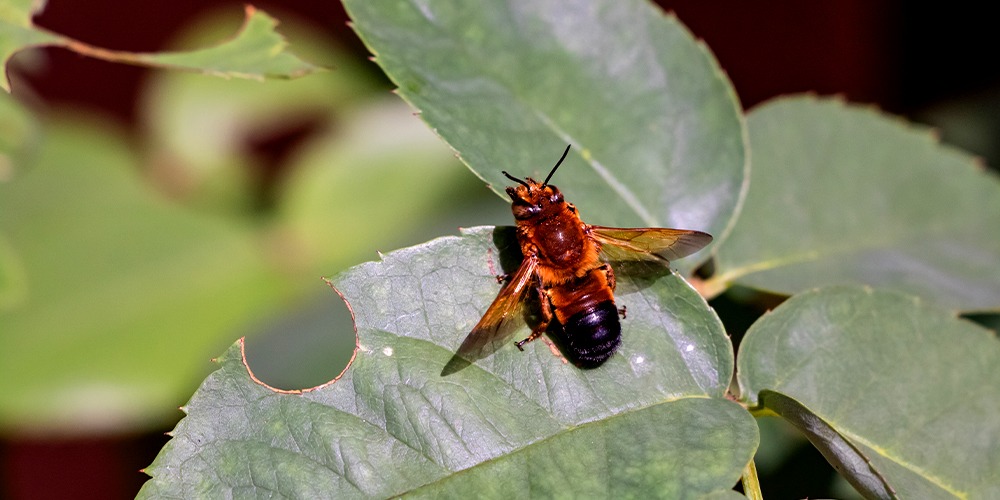
Mystery Bug: What’s Leaving Holes in my Leaves?
Another garden pest identification question we hear a lot these days concerns mysterious holes in plant foliage. In particular, strange perfect-circle holes missing from the inner foliage (almost like someone had used a hole punch) have some gardeners wondering if they have some especially sneaky caterpillars.
If you recognize these holes, I have good news for you; they’re the work of leafcutter bees! Unlike honey bees, leafcutters (as well as their blue-tinted cousin, the mason bee) are solitary bees that do not belong to a hive. They are harmless to humans, but better still, they’re extraordinarily effective pollinators. Leafcutters remove these “patches” of leaves to help build their nests and ultimately do very little damage to your plants. If you see a small, mostly-black bee, I suggest saying hello and leaving it to its own devices!
Caterpillars, on the other hand, eat from the outer edges of the leaves inwards. They tend to cause a little more damage, but the damage is necessary for their development into butterflies. Using a control method, such as BTK is effective at killing caterpillars, but it’s also non-selective, which means you can eliminate beautiful monarchs and swallowtails in the process of targeting cutworms.
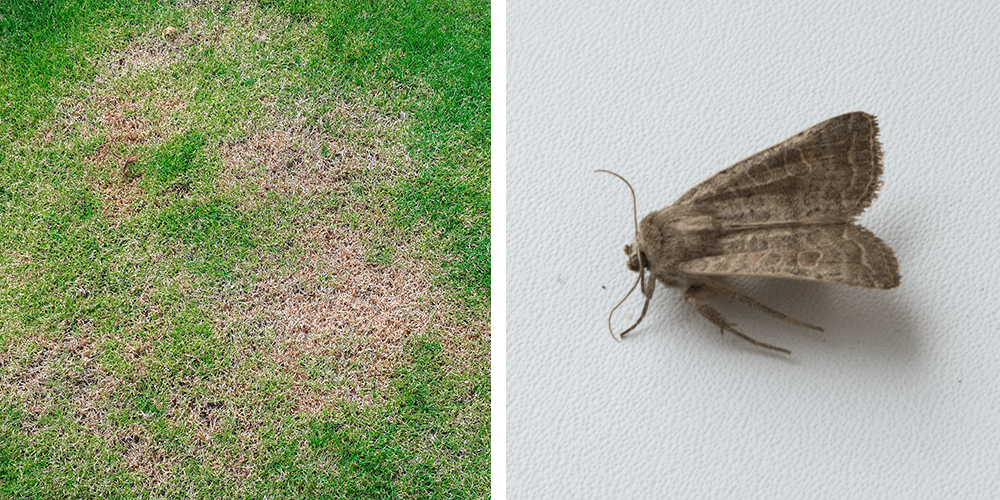
Lawn Lurkers: Outsmarting Sod Webworm
Finally, if your lawn has been struggling and you’re noticing a lot of small brown moths, your yard may be home to a sod webworm infestation. Identification of this garden pest tends to be based on the presence of the adult moths, as the larvae are hidden under the soil. They attach to the roots of grass, weakening lawns and causing swaths of brown patches.
The simplest way to control sod webworm is actually a cultural control; just overseed the lawn with clover! Sod webworm thrives in a grass monoculture, but they leave clover roots alone. If your yard contains a blend of grass and clover, sod webworms are more likely to leave your lawn alone and head to the nearest all-grass lawn.
Another option is to apply a nematode product. This is a biological control that uses a microscopic organism to target and kill lawn grubs and sod webworm. We recommend GrubOut nematodes applied with a nematode sprayer.
I hope this quick garden pest identification guide comes in handy for you this summer. However, if you notice a new or concerning pest emerging in your garden, be sure to snap photos for our gardening experts to analyze in-store. For the safety of our plants, please leave specimens of pests and diseases at home””we’d be happy to review your digital images and provide guidance and recommendations from there!



